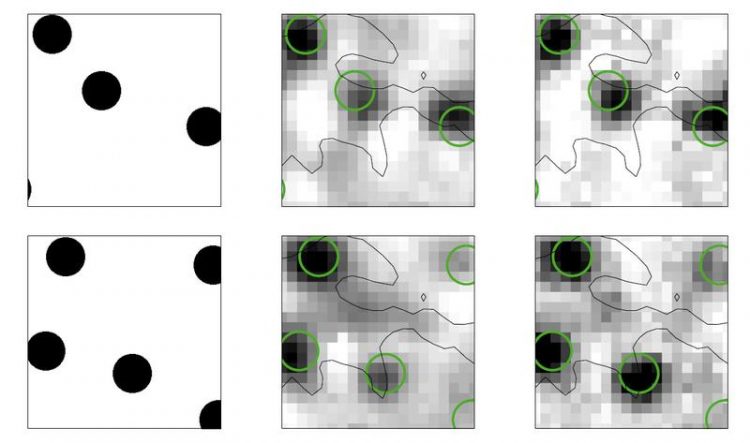Video of Moving Discs Reconstructed from Rat Retinal Neuron Signals

Reconstructing a video from the retinal activity. Left: two example stimulus frames displayed to the rat retina. Middle and right: Reconstructions obtained with two different methods Botella-Soler et al.
Neurons in the mammalian retina transform light patterns into electrical signals that are transmitted to the brain. Reconstructing light patterns from neuron signals, a process known as decoding, can help reveal what kind of information these signals carry.
However, most decoding efforts to date have used simple stimuli and have relied on small numbers (fewer than 50) of retinal neurons.
In the new study, Botella-Soler and colleagues examined a small patch of about 100 neurons taken from the retina of a rat. They recorded the electrical signals produced by each neuron in response to short movies of small discs moving in a complex, random pattern. The researchers used various regression methods to compare their ability to reconstruct a movie one frame at a time, pixel by pixel.
The research team found that a mathematically simple linear decoder produced an accurate reconstruction of the movie. However, nonlinear methods reconstructed the movie more accurately, and two very different nonlinear methods, neural nets and kernelized decoders, performed similarly well.
Unlike linear decoders, the researchers demonstrated that nonlinear methods were sensitive to each neuron signal in the context of previous signals from the same neuron. The researchers hypothesized that this history dependence enabled the nonlinear decoders to ignore spontaneous neuron signals that do not correspond to an actual stimulus, while a linear decoder might “hallucinate” stimuli in response to such spontaneously generated neural activity.
These findings could pave the way to improved decoding methods and better understanding of what different types of retinal neurons do and why they are needed. As a next step, Botella-Soler and colleagues will investigate how well decoders trained on a new class of synthetic stimuli might generalize to both simpler as well as naturally complex stimuli.
“I hope that our work showcases that with sufficient attention to experimental design and computational exploration, it is possible to open the box of modern statistical and machine learning methods and actually interpret which features in the data give rise to their extra predictive power,” says study senior author Gasper Tkacik. “This is the path to not only reporting better quantitative performance, but also extracting new insights and testable hypotheses about biological systems.”
About IST Austria – www.ist.ac.at
The Institute of Science and Technology (IST Austria) is a PhD-granting research institution located in Klosterneuburg, 18 km from the center of Vienna, Austria. Inaugurated in 2009, the Institute is dedicated to basic research in the natural and mathematical sciences.
In your coverage please use this URL to provide access to the freely available article in PLOS Computational Biology:
http://journals.plos.org/ploscompbiol/article?id=10.1371/journal.pcbi.1006057
Contact:
Name: Gasper Tkacik
Email: gtkacik@ist.ac.at
Ph: +43 2243 9000 4501
Citation: Botella-Soler V, Deny S, Martius G, Marre O, Tkačik G (2018) Nonlinear decoding of a complex movie from the mammalian retina. PLoS Comput Biol 14(5): e1006057. https://doi.org/10.1371/journal.pcbi.1006057
Funding: This work was supported by ANR TRAJECTORY, the French State program Investissements d'Avenir managed by the Agence Nationale de la Recherche [LIFESENSES: ANR-10-LABX-65], a EC grant from the Human Brain Project (FP7-720270)), and NIH grant U01NS090501 to OM, the Austrian Research
Foundation FWF P25651 to VBS and GT. VBS is partially supported by contract MEC, Spain (Grant No. AYA2013-48623-C2-2, No. AYA2016-81065-C2-2 and FEDER Funds). SD was supported by a PhD fellowship from the region Ile-de-France. GM received funding from the People Programme (Marie Curie Actions) in FP7/2007-2013 under REA grant agreement No.291734. The funders had no role in study design, data collection and analysis, decision to publish, or preparation of the
manuscript.
Competing Interests: The authors have declared that no competing interests exist.
About PLOS Computational Biology
PLOS Computational Biology (www.ploscompbiol.org) features works of exceptional significance that further our understanding of living systems at all scales through the application of computational methods. For more information follow @PLOSCompBiol on Twitter or contact ploscompbiol@plos.org.
Media and Copyright Information
For information about PLOS Computational Biology relevant to journalists, bloggers and press officers, including details of our press release process and embargo policy, visit http://journals.plos.org/ploscompbiol/s/press-and-media .
PLOS Journals publish under a Creative Commons Attribution License, which permits free reuse of all materials published with the article, so long as the work is cited.
About the Public Library of Science
The Public Library of Science (PLOS) PLOS is a nonprofit publisher and advocacy organization founded to accelerate progress in science and medicine by leading a transformation in research communication. For more information, visit http://www.plos.org.
http://journals.plos.org/ploscompbiol/article?id=10.1371/journal.pcbi.1006057 freely available article in PLOS Computational Biology
http://ist.ac.at/en/research/research-groups/tkacik-group/ Website of the research group
Media Contact
All latest news from the category: Life Sciences and Chemistry
Articles and reports from the Life Sciences and chemistry area deal with applied and basic research into modern biology, chemistry and human medicine.
Valuable information can be found on a range of life sciences fields including bacteriology, biochemistry, bionics, bioinformatics, biophysics, biotechnology, genetics, geobotany, human biology, marine biology, microbiology, molecular biology, cellular biology, zoology, bioinorganic chemistry, microchemistry and environmental chemistry.
Newest articles

Innovative vortex beam technology
…unleashes ultra-secure, high-capacity data transmission. Scientists have developed a breakthrough optical technology that could dramatically enhance the capacity and security of data transmission (Fig. 1). By utilizing a new type…

Tiny dancers: Scientists synchronise bacterial motion
Researchers at TU Delft have discovered that E. coli bacteria can synchronise their movements, creating order in seemingly random biological systems. By trapping individual bacteria in micro-engineered circular cavities and…

Primary investigation on ram-rotor detonation engine
Detonation is a supersonic combustion wave, characterized by a shock wave driven by the energy release from closely coupled chemical reactions. It is a typical form of pressure gain combustion,…



